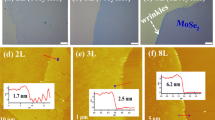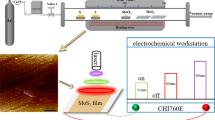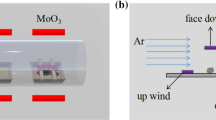Abstract
In this work, we investigated the fabrication of intriguing MoS2 nanoarray on poly (ethylene terephthalate) (PET)/Indium tin oxide (ITO) substrates through one-step vacuum thermal evaporation technology. The profiles of MoS2-based nano-bulges were regarded as domed droplets adhered on the substrates. Evaporation rate and thickness were demonstrated to codetermine the morphology of MoS2-based nanoarray. The diameters of MoS2 bulges were determined by the evaporation thickness, while the evaporation rate dominated contact angles between these bulges and ITO films. Besides the nonuniform electrical distribution, a weak van der Waals force in the horizontal direction between MoS2 molecule and jagged ITO film were proposed to be principal factors that influence the morphologies of MoS2. Finally, the field distributions of organic photovoltaic (OPV) devices with MoS2 nanoarray were simulated through finite-difference-time-domain (FDTD). The obvious absorption enhancement effects in FDTD verified the potential application of MoS2-based nanoarray serving as light-coupling layer in OPV devices.










Similar content being viewed by others
References
Vasilopoulou M, Douvas AM, Palilis LC, Kennou S, Argitis P (2015) Old metal oxide clusters in new applications: spontaneous reduction of Keggin and Dawson polyoxometalate layers by a metallic electrode for improving efficiency in organic optoelectronics. J Am Chem Soc 137(21):6844–6856. https://doi.org/10.1021/jacs.5b01889
Dennler G, Scharber MC, Brabec CJ (2009) Polymer-fullerene bulk-heterojunction solar cells. Adv Mater 21(13):1323–1338. https://doi.org/10.1002/adma.200801283
Garcia A, Welch GC, Ratcliff EL, Ginley DS, Bazan GC, Olson DC (2012) Improvement of interfacial contacts for new small-molecule bulk-heterojunction organic photovoltaics. Adv Mater 24(39):5368–5373. https://doi.org/10.1002/adma.201200963
Zhou P, Lan W, Gu J, Zhao M, Wang Z, Liao Y, Liu Y, Pu H, Ding J, Wei B (2021) High-efficiency organic photovoltaic cells with an antimony quantum sheet modified hole extraction layer. IEEE J Photovolt 11(1):111–117. https://doi.org/10.1109/jphotov.2020.3033775
Cattin L, El Jouad Z, Siad MB, Morsli M, Arzel L, Ortega E, Louarn G, Neculqueo G, Lamkaouane H, Khelil A, Addou M, del Valle MA, Mir F, Bernede JC (2020) On the use of multiple stacked active layers in organic photovoltaic cells. JMatS 55(23):9762–9774. https://doi.org/10.1007/s10853-020-04568-9
Ling ZT, Zhao Y, Wang SL, Pan SH, Lian H, Peng CY, Yang XY, Liao YJ, Lan WX, Wei B, Chen G (2019) High-performance light-soaking-free polymer solar cells based on a LiF modified ZnO electron extraction layer. J Mater Chem C 7(30):9354–9361. https://doi.org/10.1039/c9tc02363a
Lin YB, Adilbekova B, Firdaus Y, Yengel E, Faber H, Sajjad M, Zheng XP, Yarali E, Seitkhan A, Bakr OM, El-Labban A, Schwingenschlogl U, Tung V, McCulloch I, Laquai F, Anthopoulos TD (2019) 17% efficient organic solar cells based on liquid exfoliated WS2 as a replacement for PEDOT:PSS. Adv Mater 31:1902965(1-9). https://doi.org/10.1002/adma.201902965
Yuan J, Zhang YQ, Zhou LY, Zhang GC, Yip HL, Lau TK, Lu XH, Zhu C, Peng HJ, Johnson PA, Leclerc M, Cao Y, Ulanski J, Li YF, Zou YP (2019) Single-junction organic solar cell with over 15% efficiency using fused-ring acceptor with electron-deficient core. Joule 3(4):1140–1151. https://doi.org/10.1016/j.joule.2019.01.004
Zhao W, Qian D, Zhang S, Li S, Inganas O, Gao F, Hou J (2016) Fullerene-free polymer solar cells with over 11% efficiency and excellent thermal stability. Adv Mater 28(23):4734–4739. https://doi.org/10.1002/adma.201600281
He ZC, Xiao B, Liu F, Wu HB, Yang YL, Xiao S, Wang C, Russell TP, Cao Y (2015) Single-junction polymer solar cells with high efficiency and photovoltage. Nat Photonics 9(3):174–179. https://doi.org/10.1038/Nphoton.2015.6
Lan WX, Liu Y, Wu B, Xu B, Pu HY, Wei B, Peng Y, Tian WJ, Zhu FR (2019) Effect of zno electron extraction layer on charge recombination and collection properties in organic solar cells. Acs Appl Energ Mater 2(10):7385–7392. https://doi.org/10.1021/acsaem.9b01383
Hu W, Xu CY, Niu LB, Elseman AM, Wang G, Liu B, Yao YQ, Liao LP, Zhou GD, Song QL (2019) High open-circuit voltage of 1.134 V for inverted planar perovskite solar cells with sodium citrate-doped PEDOT:PSS as a hole transport layer. ACS Appl Mater Interfaces 11(24):22021–22027. https://doi.org/10.1021/acsami.9b06526
Jafari F, Patil BR, Mohtaram F, Cauduro ALF, Rubahn HG, Behjat A, Madsen M (2019) Inverted organic solar cells with non-clustering bathocuproine (BCP) cathode interlayers obtained by fullerene doping. Sci Rep 9(1):10422(1-8). https://doi.org/10.1038/s41598-019-46854-w
Singh E, Singh P, Kim KS, Yeom GY, Nalwa HS (2019) Flexible molybdenum disulfide (MoS2) atomic layers for wearable electronics and optoelectronics. Acs Appl Mater Inter 11(12):11061–11105. https://doi.org/10.1021/acsami.8b19859
Syed AA, Poon CY, Li HW, Zhu F (2019) A sodium citrate-modified-PEDOT:PSS hole transporting layer for performance enhancement in inverted planar perovskite solar cells. J Mater Chem C 7(18):5260–5266. https://doi.org/10.1039/c8tc06043f
Sun C, Wu Z, Hu Z, Xiao J, Zhao W, Li H-W, Li Q-Y, Tsang S-W, Xu Y-X, Zhang K, Yip H-L, Hou J, Huang F, Cao Y (2017) Interface design for high-efficiency non-fullerene polymer solar cells. Energy Environ Sci 10(8):1784–1791. https://doi.org/10.1039/c7ee00601b
Kim JY, Kim J, Roh J, Kim H, Lee C (2016) efficiency improvement of organic photovoltaics adopting Li- and Cd-doped ZnO electron extraction layers. IEEE J Photovolt 6(4):930–933. https://doi.org/10.1109/jphotov.2016.2553780
Wu CK, Sivashanmugan K, Guo TF, Wen TC (2018) Enhancement of inverted polymer solar cells performances using cetyltrimethylammonium-bromide modified ZnO. Materials. https://doi.org/10.3390/ma11030378
Jiang WG, Yu RN, Liu ZY, Peng RX, Mi DB, Hong L, Wei Q, Hou JH, Kuang YB, Ge ZY (2018) Ternary nonfullerene polymer solar cells with 12.16% efficiency by introducing one acceptor with cascading energy level and complementary absorption. Adv Mater 30(1):1703005(1-7). https://doi.org/10.1002/adma.201703005
Ginting RT, Jeon EB, Kim JM, Jin WY, Kang JW (2018) Dual light trapping and water-repellent effects of a flexible-based inverse micro-cone array for organic and perovskite solar cells. Acs Appl Mater Inter 10(37):31291–31299. https://doi.org/10.1021/acsami.8b08669
Heo SW, Le THH, Tanaka T, Osaka I, Takimiya K, Tajima K (2017) Cumulative gain in organic solar cells by using multiple optical nanopatterns. J Mater Chem A 5(21):10347–10354. https://doi.org/10.1039/c7ta01897e
Peer A, Biswas R (2014) Nanophotonic organic solar cell architecture for advanced light trapping with dual photonic crystals. ACS Photonics 1(9):840–847. https://doi.org/10.1021/ph500124q
Sergeant NP, Hadipour A, Niesen B, Cheyns D, Heremans P, Peumans P, Rand BP (2012) Design of transparent anodes for resonant cavity enhanced light harvesting in organic solar cells. Adv Mater 24(6):728–732. https://doi.org/10.1002/adma.201104273
Erwin WR, Zarick HF, Talbert EM, Bardhan R (2016) Light trapping in mesoporous solar cells with plasmonic nanostructures. Energy Environ Sci 9(5):1577–1601. https://doi.org/10.1039/c5ee03847b
Lan WX, Wang YW, Singh J, Zhu FR (2018) Omnidirectional and broadband light absorption enhancement in 2-D photonic-structured organic solar cells. ACS Photonics 5(3):1144–1150. https://doi.org/10.1021/acsphotonics.7b01573
Lan W, Cui Y, Yang Q, Lo M-F, Lee C-S, Zhu F (2015) Broadband light absorption enhancement in moth’s eye nanostructured organic solar cells. AIP Adv. https://doi.org/10.1063/1.4921993
Guo KP, Si CF, Han C, Pan SH, Chen G, Zheng YQ, Zhu WQ, Zhang JH, Sun C, Wei B (2017) High-performance flexible inverted organic light-emitting diodes by exploiting MoS2 nanopillar arrays as electron-injecting and light-coupling layers. Nanoscale 9(38):14602–14611. https://doi.org/10.1039/c7nr03920d
Cui Y, Zhou Z, Gao Y, Lei L, Cao J, Wu R, Liang L, Huang Z (2021) Energy saving intermittent electro-Fenton system combined with commercial MoS2 for effective Rhodamine B degradation. J Clean Prod. https://doi.org/10.1016/j.jclepro.2021.125807
Wu A, Gu Y, Xie Y, Yan H, Jiao Y, Wang D, Tian C (2021) Interfacial engineering of MoS2/MoN heterostructures as efficient electrocatalyst for pH-universal hydrogen evolution reaction. JAllC. https://doi.org/10.1016/j.jallcom.2021.159066
Xing W, Chen Y, Wang X, Lv L, Ouyang X, Ge Z, Huang H (2016) MoS2 quantum dots with a tunable work function for high-performance organic solar cells. ACS Appl Mater Interfaces 8(40):26916–26923. https://doi.org/10.1021/acsami.6b06081
Dubrovskii VG (2014) Nucleation Theory and Growth of Nanostructures. https://doi.org/10.1007/978-3-642-39660-1
Wang M, Liang J, Tang Q, Ming X, Meng J, Ding Y (2006) Surface free energy of copper-zinc alloy for energy-saving of boiler. Rare Met 25(6):324–327. https://doi.org/10.1016/s1001-0521(07)60098-9
Acknowledgements
This work was financially supported by the National Natural Science Foundation of China (62005152,62073208 and 91748116).
Author information
Authors and Affiliations
Corresponding author
Ethics declarations
Conflicts of interest
The authors declare that there are no conflicts of interest related to this article.
Additional information
Handling Editor: Mark Bissett.
Publisher's Note
Springer Nature remains neutral with regard to jurisdictional claims in published maps and institutional affiliations.
Supplementary Information
Below is the link to the electronic supplementary material.
Rights and permissions
About this article
Cite this article
Pu, H., Zhou, P., Lan, W. et al. Steerable fabrication of MoS2 nanoarray through one-step vacuum thermal evaporation technology. J Mater Sci 56, 16558–16569 (2021). https://doi.org/10.1007/s10853-021-06230-4
Received:
Accepted:
Published:
Issue Date:
DOI: https://doi.org/10.1007/s10853-021-06230-4




